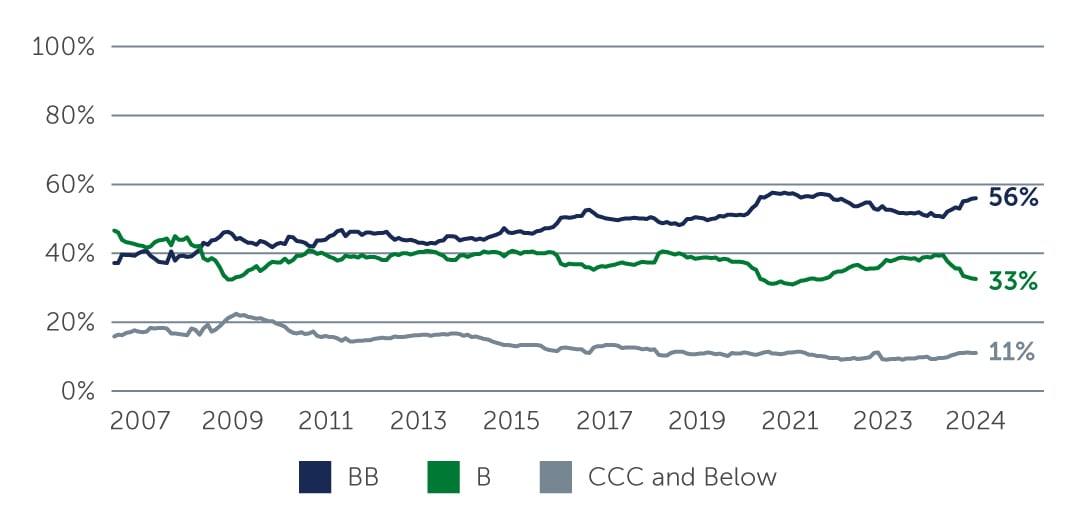High Yield: Resilience Amid a Shifting Backdrop
With the favorable fundamental and technical backdrop firmly in place, and attractive income opportunities remaining in both bonds and loans, the case for high yield continues to be compelling.
High yield remains well-positioned against a macro backdrop that gives us both reasons for confidence and concern. On the confidence side, it appears that market worries about a near-term U.S. recession may have been premature. Following the U.S. Federal Reserve’s (Fed) interest rate cut in September, the market was quick to price in a fast and steep trajectory of rate cuts for the remainder of 2024 and 2025. Now, with the recent strong jobs number in the U.S., and ongoing strength in housing demand and retail sales, it appears that the economy is stronger than some had expected, and aggressive Fed action may not be necessary. This more robust economic backdrop is a net positive for high yield issuers overall.
On the concern side, we have highlighted in recent commentaries our worries about the rise of geopolitical risk. This continues to ratchet higher with the escalation of the conflict in the Middle East, the ongoing war in Ukraine and the uncertain outcome of the U.S. election. While almost impossible to price in potential geopolitical tail risks, we remain cautious about the volatility that could be injected into markets on the back of any one of these situations. Additionally, the macro backdrop in Europe looks less rosy than what we are witnessing in the U.S. We anticipate further central bank easing to combat slowing growth, but expect that even low to modestly negative economic growth would not materially impede the return prospects for most European high yield issuers. Additionally, the high yield market’s strong fundamentals and positive technical forces serve as a stable counterweight.
Strength in Fundamentals and Technicals
High yield issuers remain in good financial health overall, with earnings growth taking place at a slow and steady rate that is in line with expectations. While there is some divergence across sectors, the changing interest rate landscape—even if slower than some had expected—should offer some relief to issuers, particularly those in more cyclical sectors like automotives. In addition, in the years following the pandemic, many issuers took steps to shore up their financial positions. In the U.S., net leverage remains low at 3.5x, while interest coverage is at 4.3x.1 Although European economic growth continues to lag the U.S., the fundamental picture is similar, with net leverage at 3.2x, and interest coverage at 4.6x.
Adding to this strong credit story is the robust ratings profile of the market. The percentage of BB issuers in the global high yield bond index remains near all-time highs, at 56%, while the percentage of CCC issuers is around 11%—roughly half of what it as a decade ago (Figure 1).
Figure 1: A Higher-Quality Market
 Source: ICE BofA. As of September 30, 2024.
Source: ICE BofA. As of September 30, 2024.
From a technical standpoint, the strong forces that have prevailed in the high yield market throughout 2024 have grown even stronger in recent months. Simply put, demand for high yield bonds and loans has been considerably greater than supply. The low supply in the market is largely due to the continued dearth of M&A activity—and while lower rates should ultimately encourage M&A activity tick up, this could take some time and should keep the technical backdrop supportive in the coming months. Another contributor is that fewer public companies are issuing new debt, with most having refinanced during the period of ultra-low rates. On the bond side, given the improving credit quality of the high yield market overall, many issuers have been upgraded to investment grade status, contributing to a shrinking market and further pressuring supply. The attractiveness of potential returns in the face of this limited supply will likely remain a forceful market tailwind.
Compelling Opportunity Set in Loans & Bonds
Given the fundamental strength of the asset class, we continue to see benefits to a strategic allocation to both high yield bonds and loans. In particular, while some investors may try to opportunistically time their entry into the market, we believe this approach may miss the attractive income and risk-reward profile presented by long-term core allocations to the asset class (Figure 2).
Figure 2: Time Earning Coupon Income Outweighs Timing of Entry and Exit
 Source: ICE BofA. As of September 30, 2024. The Timed (%) series is intended to show the total return outcome from investing in the Global High Yield market (as measured by the ICE BofA Non-Financial Developed Markets High Yield Index) with perfect hindsight around default rates. It is calculated by using Global High Yield total returns during the grey highlighted periods in the chart, and using the risk free rate (as measured by the ICE BofA U.S. 3-Month Treasury Bill Index) for the remaining periods.
Source: ICE BofA. As of September 30, 2024. The Timed (%) series is intended to show the total return outcome from investing in the Global High Yield market (as measured by the ICE BofA Non-Financial Developed Markets High Yield Index) with perfect hindsight around default rates. It is calculated by using Global High Yield total returns during the grey highlighted periods in the chart, and using the risk free rate (as measured by the ICE BofA U.S. 3-Month Treasury Bill Index) for the remaining periods.
We continue to see value in loans and this confidence has been further bolstered by the recent strong economic data in the U.S. In this still-elevated interest rate environment, loans continue to offer the potential for compelling returns. Specifically, the average coupon for global loans today remains above the long-term average, at 8.6% and remains a key driver of demand.2 Another benefit of loans is that unlike other fixed income assets, the majority of the return is coming from contractual income that is paid today rather than awaiting price recovery. This income component his resulted in a steadier return profile over time.
Within loans, we also continue to see value in select discounted opportunities such as liability management exercise (LME) transactions. These have become more prevalent in financially stressed situations, essentially offering issuers ways to recast or restructure their existing debt arrangements. While these transactions must be navigated carefully, they can offer compelling value for managers that have the resources to rigorously analyze the attendant risks.
The bond market is also supported by tailwinds in the medium term. In particular, the total return story continues to be compelling today, with yields on BB and single-B bonds around 5.5% and 6.9%, respectively.3 Against a backdrop of overall fundamental strength and the robust U.S. economy, we also see select opportunities in issuers in more challenged sectors that have already been through an earnings recession, such as chemicals, health care and technology. The companies in these sectors tend to have higher leverage, discounted prices and wider spreads. While it can be difficult to forecast the timing of individual credit turnarounds, many have good liquidity and are able to service their debt—and should ultimately benefit from central bank rate-cutting. That said, uncertainties remain, which means a cautious approach is required to identifying the potential winners and losers in this dynamic market.
Looking Ahead
We continue to see material tailwinds supporting high yield for the remainder of 2024 and into 2025. But within the broader asset class, we expect that the best relative value at any given time will continue to move around. As such, we believe managers need to be nimble and able to shift between geographies and asset classes as opportunities arise.
As always, there are risks on the horizon—the U.S. presidential election and ongoing wars in Ukraine and the Middle East all have the potential to trigger both short-term bouts of volatility and longer-term economic repercussions. However, the fundamental strength of the market, coupled with the array of idiosyncratic opportunities that can arise in a market as diverse as high yield, underscore the value investors can uncover, particularly when partnering with experienced managers that have deep resources and in-depth credit research and analysis capabilities.
1. Source: CreditSights. As of June 30, 2024.
2. Source: Credit Suisse. As of September 30, 2024.
3. Source: Credit Suisse. As of September 30, 2024.






